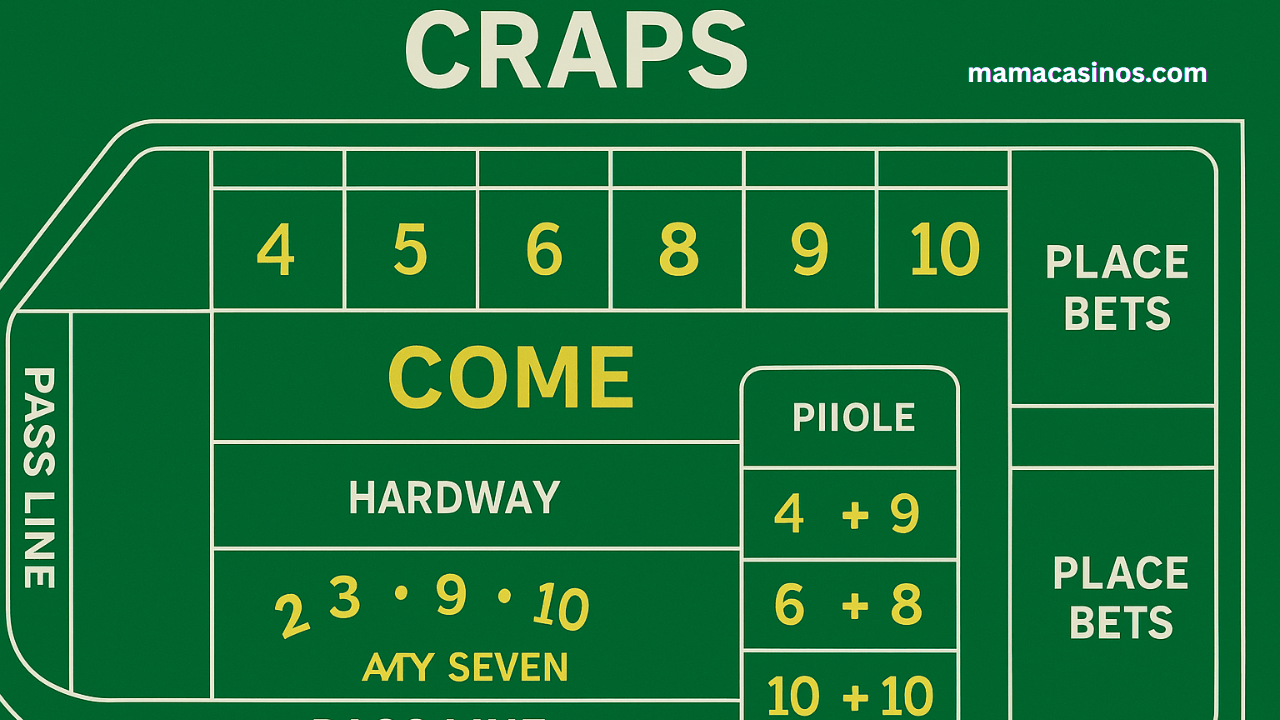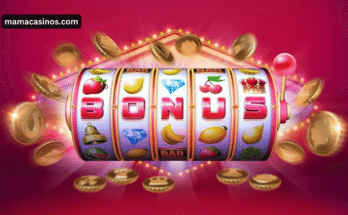If you’ve ever walked into a casino and seen a large green table surrounded by cheering players and bouncing dice, you’ve seen a craps table. At first glance, it looks confusing — covered in boxes, numbers, and betting areas. But once you understand the craps table layout, the game becomes exciting, social, and strategic.
What Is a Craps Table?
A craps table is where one of the most thrilling casino games takes place. The game involves two dice, players placing bets on the outcome of rolls, and a crew of dealers managing chips and payouts.
The table is large — typically around 12 to 14 feet long — and designed to accommodate multiple players. Every betting option available in the game is displayed directly on the felt surface.
Key features of a craps table:
-
A raised padded rail where players place chips.
-
A green felt surface printed with numbers and betting areas.
-
Two sides (left and right) mirroring each other for multiple players.
-
A central area reserved for “proposition bets.”
Understanding the layout is the first step toward mastering craps.
Why Understanding the Craps Table Layout Matters
Learning the table layout is not just for looks — it’s essential for smart gameplay.
Here’s why it matters:
-
Avoids confusion: The layout looks complex, but knowing where bets go prevents mistakes.
-
Speeds up play: You can place bets faster and more confidently.
-
Improves odds: Knowing which areas favor players helps you make smarter bets.
-
Increases enjoyment: Once you understand the layout, craps becomes one of the most social and fun casino games.
A good grasp of the layout gives you an edge even before the dice roll.
Craps Table Layout Diagram Explained
Imagine a large rectangular table divided into three sections:
-
The two side areas – identical sections for players on each side.
-
The center area – for advanced bets (called proposition bets).
Each section is designed for different bet types.
🟢 Pass Line
The most common and beginner-friendly bet. Placed around the outer edge labeled “Pass Line.”
🔴 Don’t Pass Line
Opposite of the Pass Line. You’re betting against the shooter.
⚪ Come & Don’t Come Bets
Located near the center. These bets act like Pass/Don’t Pass bets but are placed after the first roll.
🟣 Field Bets
Single-roll bets found in a wide section labeled “Field” near the bottom center.
🔵 Place Bets
Located in number boxes (4, 5, 6, 8, 9, 10). You bet that one of these numbers will roll before a 7.
🟡 Proposition Bets (Center Table)
High-risk, high-reward bets like Hardways, Any Seven, or Craps 2, 3, 12.
Craps Table Sections in Detail
1. The Main Betting Area
This is where most casual players bet — Pass Line, Come, Field, and Place bets.
It’s safe, simple, and offers better odds.
2. The Center (Proposition) Area
Run by the “stickman,” this section contains risky one-roll bets and Hardways.
These bets are exciting but carry a high house edge.
3. Dealer and Stickman Zones
-
Stickman: Uses a stick to move dice and control game flow.
-
Boxman: Manages chips and payouts.
-
Base Dealers: Handle bets for players on their respective sides.
Knowing who controls which area helps you place bets efficiently.
Common Craps Bets and Their Locations
| Bet Type | Table Location | Payout | Risk Level |
|---|---|---|---|
| Pass Line | Outer edge | 1:1 | Low |
| Don’t Pass | Next to Pass Line | 1:1 | Low |
| Come | Near center | 1:1 | Low |
| Don’t Come | Next to Come | 1:1 | Low |
| Field | Middle bottom | 1:1, 2:1, 3:1 | Medium |
| Place Bets | Number boxes (4–10) | Varies | Medium |
| Hardways | Center area | 7:1 to 9:1 | High |
| Any Seven | Center | 4:1 | High |
| Craps (2, 3, 12) | Center | 7:1 to 30:1 | High |
How to Read a Craps Table (Beginner’s Guide)
-
Find the Pass Line: Always your safest first bet.
-
Watch the Point Number: Once the shooter rolls, the point number (4, 5, 6, 8, 9, or 10) lights up.
-
Follow the Dice: Bets depend on the dice outcome — win, lose, or roll again.
-
Avoid Proposition Bets Initially: They may look fun, but they carry higher risk.
-
Stick to Basic Bets: Pass Line and Come bets give the best player odds.
When to Bet and When to Avoid Risky Spots
✅ When to Bet:
-
On the Pass Line during a come-out roll.
-
After a point is established — use Come bets to expand coverage.
-
Use Odds bets (behind Pass Line) — they have zero house edge.
❌ When to Avoid:
-
Any Seven or Proposition bets — high payout but poor odds.
-
Hardways — exciting but risky for beginners.
-
During heated streaks — avoid emotional bets.
Where to Stand and Place Your Bets
A craps table accommodates up to 20 players, and both sides mirror each other.
-
Stand near the dealer for easy access to your chips.
-
Place chips neatly on the betting area.
-
Never throw or slide chips — always hand them to the dealer for complex bets (like Hardways).
How to Calculate Craps Odds Easily
Example:
You place $10 on the Pass Line.
If the shooter rolls a 7 or 11, you win $10.
If they roll a 2, 3, or 12, you lose.
If another number appears (say 8), that becomes the point. You win if 8 rolls again before 7.
👉 The house edge on a Pass Line bet is only 1.41%, making it one of the best bets in the casino.
Craps Table Etiquette
Craps is a fast, community-driven game. Follow these etiquette tips:
-
Don’t touch the dice after placing bets.
-
Keep drinks away from the felt.
-
Don’t throw chips after dice are out.
-
Use clear, polite language with dealers.
-
Tip your dealers for great service.
Good manners make the game more enjoyable for everyone.
Printable Craps Table Layout Guide
If you’re learning online, download or print a craps table diagram.
Include these areas:
-
Pass Line & Don’t Pass
-
Field Section
-
Come & Don’t Come boxes
-
Proposition area (center)
-
Place bet boxes (4, 5, 6, 8, 9, 10)
Keep it nearby when practicing in free online games.
FAQs About Craps Table Layout
1. What is a craps table layout?
It’s the design printed on the table showing all betting areas — Pass Line, Field, Come, and more.
2. Why is the table split into two sides?
So more players can join the same game and access identical betting areas.
3. Where should beginners start betting?
Always start with the Pass Line — it’s simple and has great odds.
4. How big is a craps table?
Typically 12 to 14 feet long and about 5 feet wide.
5. Can I use a cheat sheet while learning craps?
Yes! Many online players use printable table layouts to learn faster.
6. What’s the safest bet on the table?
The Pass Line bet offers the lowest house edge (1.41%).
Conclusion – Master the Craps Table Layout for Winning Confidence
Learning the craps table layout is your key to enjoying one of the most exciting casino games ever invented.
By knowing:
-
What each section means,
-
Where to place bets,
-
When to bet safely, and
-
How to manage risk,
you’ll play more confidently and have more fun.
Start with basic bets like Pass Line and Come, then gradually explore advanced areas once you feel comfortable.
Craps isn’t about luck alone — it’s about understanding the table, making smart choices, and joining the thrill with every roll.




